
Everyone has their favourite Scottish animal, the one they’re always on the lookout for, the one that stops them in their tracks. But while I love a white-tailed eagle or a red squirrel as much as the next person, my favourite Scottish animal isn’t big, fluffy or familiar.
It’s small, it’s uncommon and it’s downright weird. Erm…..it’s a beetle. Yes, I can hear your inward groans, but bear with me.
It’s actually surprising to encounter something utterly alien. By that I mean, we’re all generally aware that insects are enormously varied in appearance but we nevertheless expect the ones we do encounter to fit neatly into established ‘norms’: flies look like flies; ants look like ants; bees look like bees. And most of the time, beetles look like beetles.
But there I was, walking through Glen Uig in Angus, when I spied a conspicuous black blob on the track. In bright sunlight it had a metallic sheen, visibly iridescent, and so it stood out a mile. I assumed it would just be a standard large ground beetle but the closer I got the less familiar it became, and so it stopped me in my tracks as readily as a sunbathing adder might do.
“What the hell IS that!!!???”
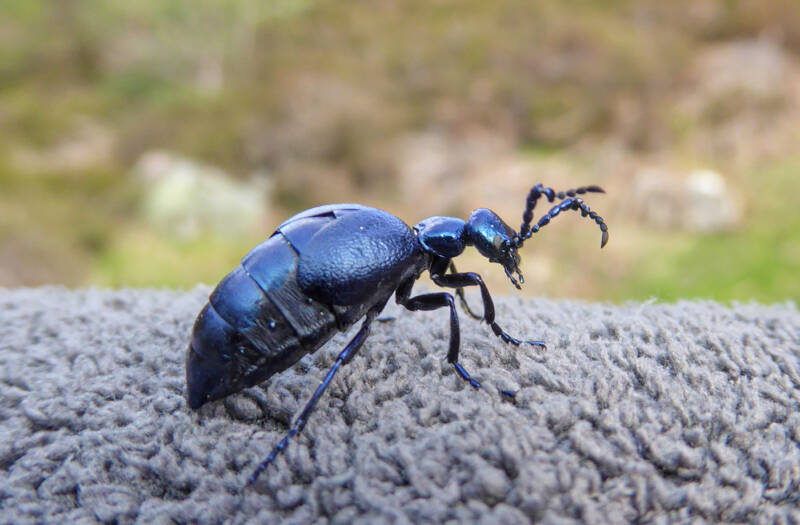
Quality Street
In all my years I had never seen anything like it. About an inch long, up close it was a beautiful blueish-purple colour and its pot-marked exoskeleton looked tough, like metal. It had a large, oddly ant-like head with two clearly defined eyes and a pair of long antennae. The latter were notched into multiple segments and had such a pronounced kink I thought maybe they’d been snapped in a fight.
It had elytra (protective wing cases) on its abdomen but these were so small and overlapping that it seemed unlikely this creature could fly. The thorax (the mid-section behind the head, onto which the legs attach) was the same size as the head, but both were dwarfed by an absolutely humongous abdomen, which looked like it had been over-inflated to the point of bursting. Picture the big purple one from a box of Quality Street being towed by an ant, and you’re halfway there.
I know it probably sounds monstrous, but this not-so-wee bulbous blue blob was oddly charismatic and endearing. Unlike most other beetles that race jerkily about the place, seemingly living their lives on permanent fast forward, this thing was slow and fumbling, struggling to negotiate even the broadest blades of grass. I lowered my hand and let it crawl on so I could get a better look.
As it ambled along my arm, it would stop every so often and then very slowly and deliberately turn its wee head left….then right, all the while twitching its peculiarly-notched antennae before resuming its course. Every movement felt almost thoughtful or considered.
Hmm, maybe the fact it clearly lived its life at a more leisurely speed made it seem less like an insect and more like a …….oh I don’t know, but certainly something much more relatable.
I put the beetle (for I was now assuming it WAS a beetle of some kind) down on the sandy Cairngorms soil. I must have spent a further 15 minutes just watching it go about its business, mulling the weirdness over in my head, before I resumed my walk towards Backwater Reservoir.
When I got home I interrogated Google with ‘Scotland beetle massive abdomen’ and hey presto, there it was.
“An oil beetle? Never heard of them!”
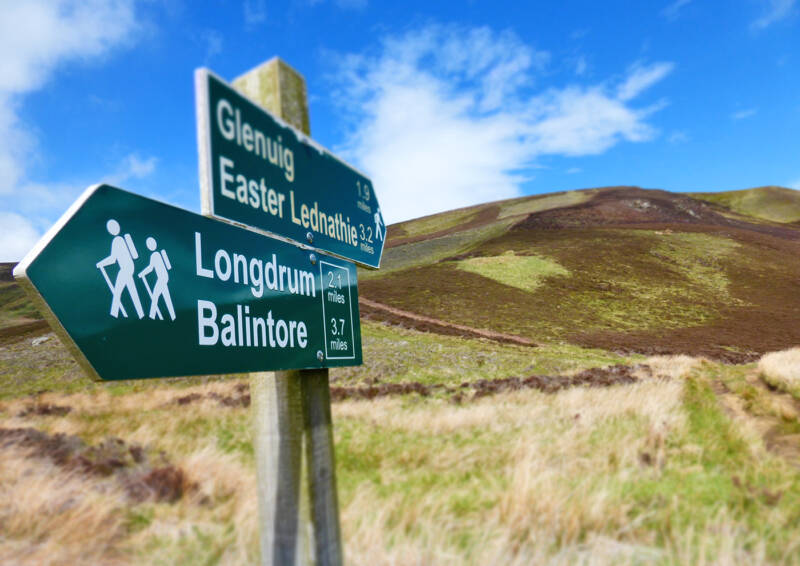
Blistering backstory
I learned that the UK has five species: the Rugged, the Mediterranean, the Violet, the Black, and the very rare Short-Necked. Only the last three of those are found in Scotland, and I managed to identify mine as a Violet Oil Beetle.
They are indeed flightless, and the heavily kinked antennae indicated this was a male – apparently these help him to hold onto the female during mating.
I also learned that oil beetles are mostly rather rare, and I did wonder whether that’s because something so large, lumbering and conspicuous was bound to make an easy meal for any number of would-be predators. How could something that ungainly possibly thrive despite itself? Well, this is where their name comes in.
The ‘oil’ is their internal body fluid. It’s called ‘haemolymph’, and is something that all insects have. It bathes their internal tissues, and transports waste and nutrients around their bodies. You could think of it as their equivalent of blood if you like, but that’s still way off the mark as it doesn’t contain red blood cells and it doesn’t get transported via arteries or veins.
Oil beetles actually belong to a family of insects called Meloidae, and the family’s common name, ‘Blister Beetles’, gives you some idea of what kind of a defence they can employ if they’re threatened. They secrete haemolymph out of their leg joints to repel would-be predators, and unlike most insects, the haemolymph of blister beetles contains a chemical called cantharidin.
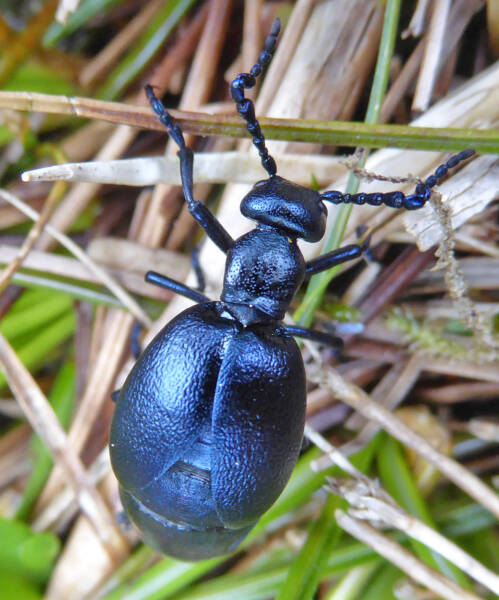
If ingested, cantharidin can be extremely toxic to many animals, including humans, but even small amounts on the skin can cause blistering on some people. I don’t know what the concentration of cantharidin is in an oil beetle, but in some more exotic blister beetles it is rather potent. There are a few thousand blister beetle species but the ‘Spanish fly’ in particular is rather infamous in this regard.
Neither unique to Spain nor a fly, Spanish Fly is absent from Scotland but is widely distributed across Europe and Asia, and can be found in the far south of England. Its dried, pulverised remains have been used in medicine (administered as ‘cantharides’) for over 2000 years to treat all kinds of weird things – piles, ulcers, rabies and even hair loss. And while the obvious hazards of cantharidin would, you think, make it an unlikely candidate for a popular aphrodisiac, the insect was widely harvested to produce a compound for this express purpose, and was named ‘Spanish fly’ after its source.
Spanish Fly was notoriously dangerous to ingest, and accounts of both accidental and deliberate poisonings abound. Indeed there are court records from 1772 of the trial of the Marquis de Sade, who laced chocolates with Spanish Fly and then gave them to prostitutes in Marseilles. They were violently ill but survived, and de Sade was subsequently sentenced to death in absentia for poisoning (and a number of other unpleasant things).
These days cantharidin is still used as an active ingredient for removing warts and verrucas, as it causes the wart to blister and rise up off the skin. The compound is also of interest in cancer research for leukemia, breast cancer and prostate cancer among others, and seemingly it has historically been used in tattoo removal too. But for goodness sake don’t rush out and start smearing blister beetles on yourself!
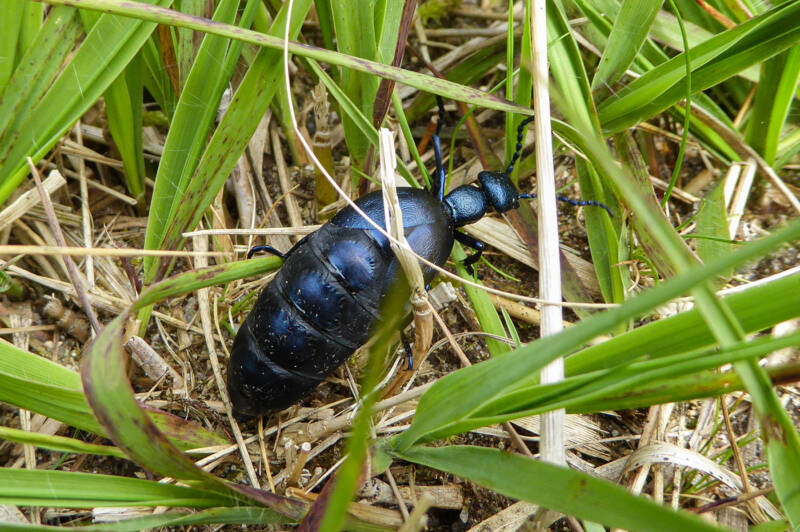
Despite a long search online I couldn’t find out whether we humans can synthesise the compound artificially these days without needing to harvest it direct from insects, but by that point the oil beetle had already led me down such a long, winding rabbit hole that my mind was well and truly blown. I was completely unaware of its intriguing backstory when I encountered my first oil beetle, and I have to say, the revelations about cantharidin made the wee thing somewhat more threatening than its lumbering, almost comical ambulations would suggest.
There is however no reason to fear these remarkable creatures, although I admit I’m certainly in less of a rush to handle them these days. If nothing else it serves as a valuable lesson not to go rushing to pick things up, even if the source of your fascination is apparently slow, clumsy, charismatic and….dare I say…..rather adorable.
The departure lounge
The oddness doesn’t stop there, however, for the charismatic adult you see before you is just the culmination of an equally odd and extraordinary life cycle.
Once the adult oil beetle has mated, she digs a burrow in the ground a few inches deep and then lays thousands of eggs. As with many other insects, after the larvae hatch they will go through several pre-adult ‘moults’ as they grow in size. However, unlike most insects these larval stages don’t all look the same as one another.
The first stage, immediately after hatching, are tiny but highly mobile louse-like creatures called…..wait for it…..triungulins. They get their name from the Latin word ‘ungula’, meaning hoof or claw. So Tri-ungulin = Three claws.
They need to eat a lot of food to power their way to the next larval stage, so they make for high ground, up the stems of nearby flowers such as dandelions. No mean feat when you’re not even 2mm long!
They’re not visiting the flowers for food, though. Nope, the triungulins want to travel, and so the flowers are less a restaurant and more an airport departure lounge.
Oil beetle triungulins are however very specific about what flight they want, and what destination they want to fly to. They need ready-made burrows stashed with food, and to get there they need bees. Not bumblebees, not honey bees, not even wasps. No, they need solitary mining bees – bees that excavate chambers underground to build their nests, into which the bee deposits an egg and a stash of pollen for its unhatched young.
When the right bee comes along, the triungulins climb onboard with their hooked legs and then fly back to the unsuspecting bee’s nest. Unsurprisingly, many pollinating aviators other than solitary mining bees will visit the flower to feed, and so the oil beetle strategy isn’t foolproof because triungulins do latch on to other insects too.
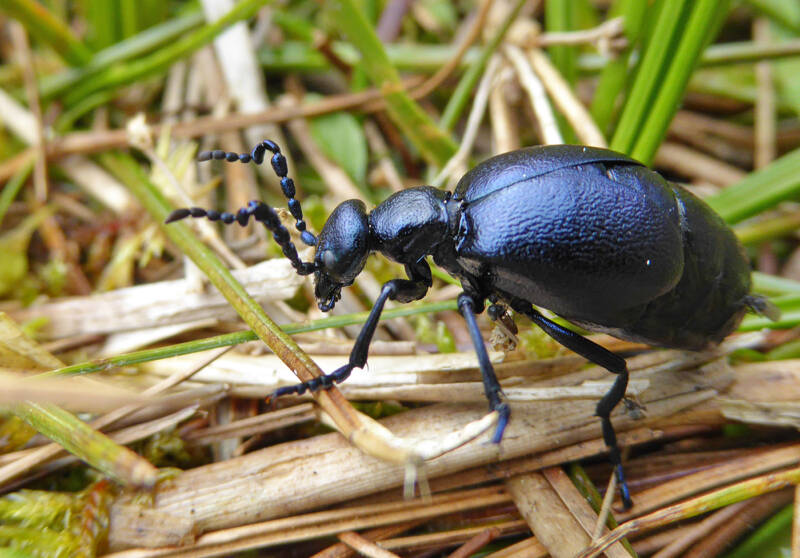
Statistically therefore, a large number of triungulins never make it to the burrow of a mining bee, but what nature lacks in precision it more than makes up for in numbers. Oil beetles lay thousands of eggs, which hatch into thousands of triungulins. So while many triungulins won’t arrive at their chosen destination, some will.
Once in a mining bee’s nest, the triungulins make themselves comfortable by feasting on the bee’s egg and food store. Thereafter, the oil beetle larvae don’t need to be mobile so they become more grub-like with each moult. Eventually the large immobile grub pupates and turns into an adult oil beetle, who then digs their way out to the surface and then ambles off to feed, find a mate, and start the whole mad process all over again.
Bonkers eh?
Help stop the decline
Given the oil beetle’s very niche and complex requirements in terms of host species and habitat, not least the ongoing plight of our bee species, it’s not surprising that they’ve experienced a significant decline in recent decades – a combination of habitat loss, pesticides and doubtless other things we’re as yet unaware of.
As a result, the UK has already lost three of its eight oil beetle species. Of our three Scottish species, the Violet Oil Beetle is the one you’re most likely to encounter on account of it being less fussy (seriously!) than its close relatives.
It can live in a broader range of environments and habitats than the Black or the Short-Necked oil beetles, which favour more lowland or coastal sites. The violet oil beetle likes woodland edges, wildflower rich grassland, heaths and moors, and definitely likes exposed bare ground.
Still, even violet oil beetles are an infrequent sight, and an encounter therefore remains something of a privilege. Years can go by between my sightings, and indeed years HAD gone by since my last sighting, but then in May this year I encountered two violet oil beetles in the space of three days. Both were on Mar Lodge Estate in the Cairngorms, and both were in locations where the species hadn’t been recorded before.
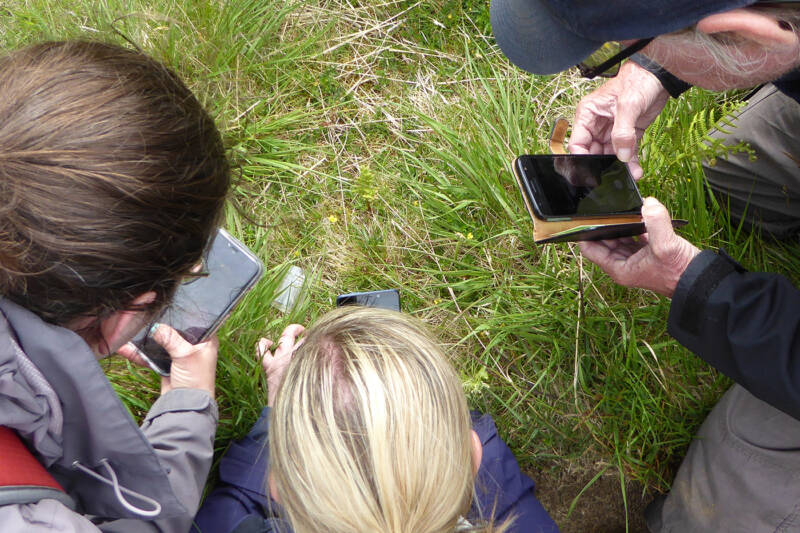
That’s not to say they have recently moved in or are doing well, rather that species like this, so often overlooked in the grand scheme of things, are notoriously under-recorded. For that reason, and to enable a better understanding of the health of these enigmatic wee things, if you’re fortunate enough to encounter an oil beetle I’d encourage you to log it via the iRecord app along with piccies if possible. The UK Oil Beetle Recording Scheme has a good overview of how you can help, as well as links to help you identify your oil beetle – see this link.
But even before you get that far, mind to put the phone away and take time to actually watch your beetle go about its business. Study its movements, get to know it better, and frankly just marvel at the improbable sequence of events and chance encounters that enabled this wee weirdo to be crawling clumsily in front of you.
How can anyone possibly resist the oil beetle!? Cute, charismatic, with a blistering backstory and a fire inside, they are thoroughly deserving of my top spot.
